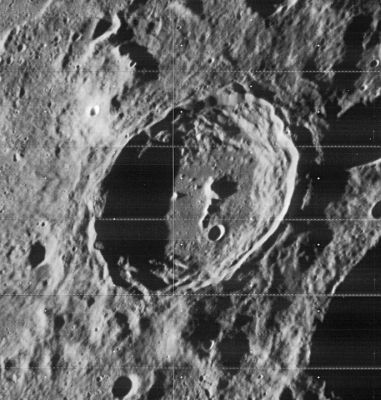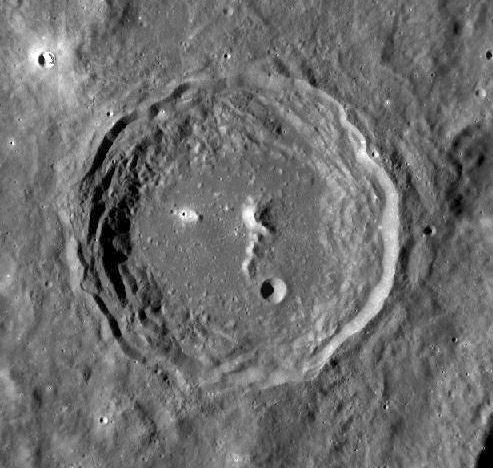La Pérouse
Contents
La Pérouse
(current IAU name; original IAU name: Lapéyrouse)
| Lat: 10.7°S, Long: 76.3°E, Diam: 77 km, Depth: km, Rukl: 49 |


LO-IV-178-h1; LRO-WAC mosaic
Images
LPOD Photo Gallery Lunar Orbiter Images Apollo Images
- Orbital photographs of the unusual bright ray-craterlet La Pérouse A, northwest of La Pérouse:
- Apollo 12's orbital Hasselblad AS12-55-8163 shows both La Pérouse and La Pérouse A (the sharp craterlet in the frame's upper left corner).
- Apollo 15's orbital Hasselblad close-ups of La Pérouse A: AS15-81-10906, AS15-81-10907, and AS15-81-10922. See also at 198:43:15 GET and 199:49:57 GET in the mission of Apollo 15 (A15 Flight Journal: Orbital Science and Crew Rest).
- Apollo 15's orbital Fairchild-metric frames made during Revolution 60 (frames 1983/ 1984/ 1985/ 1986/ 1987).
- Apollo 15's orbital Fairchild-metric frames made during Revolution 62 (frames 2097/ 2098/ 2099/ 2100/ 2101).
- Apollo 15's orbital Fairchild-metric frames made during Revolution 63 (frames 2241/ 2242/ 2243/ 2244/ 2245).
- Apollo 15's orbital Itek-panoramic frames AS15-P-10058, AS15-P-10063, AS15-P-10065.
- Research Apollo photographs: Danny Caes.
- Telescopic observers of the Waning Gibbous Moon (shortly after Full Moon) may notice that the ray-craterlet La Pérouse A stands out as a very bright dot! See LPOD A Sparkling Diamond
Maps
Description
La Pérouse is one of a relatively large number of limb craters that are not often observed and hence often require a map to identify. La Pérouse is limbward of Langrenus in a seldom observed area. At 77 km in diameter it is typical complex crater with terraces, central peak and relatively flat foor. La Pérouse is a fairly fresh crater - although it does have a later impact on its floor - but the Clementine high Sun view shows it has no ray system and thus is probably more than a billion years old. There are slumped terraces and a significant scarp at the top of the eastern wall. This is probably another steep place on the Moon. (Modified from Oct 11, 2006 LPOD.)- tychocrater Jun 28, 2007
Description: Elger
(IAU Directions) LA PEYROUSE.--A much foreshortened walled-plain, 41 miles in diameter, close to the limb, S.E. of Langrenus. There is a longitudinal ridge on the floor. Between it and Langrenus are two large ring-plains with central mountains, and on the N.W., La Peyrouse A, a bright crater, adjoining which is La Peyrouse DELTA, one of the most brilliant spots on the moon.
Description: Wikipedia
Additional Information
- Central peak height
- Sekiguchi, 1972: 2 km
- 2 other peaks adjacent to the central peak, in order from north to south, have heights of 1km & 2km Sekiguchi, 1972- fatastronomer fatastronomer
- Sekiguchi, 1972: 2 km
- Central peak composition: GNTA1 & GNTA2 (Tompkins & Pieters, 1999)
Nomenclature
- Named for Jean François de Galaup, comte de La Pérouse (August 23, 1741–1788?), a French Navy officer and explorer whose expedition vanished in Oceania.
- This feature was catalog entry 4767 in the original IAU nomenclature of Blagg and Müller, where it was spelled Lapeyrouse, a name attributed to Mädler.
- It was changed to La Pérouse in IAU Transactions XIB (1961).
- NASA SP-241 (not an official IAU document) insists the correct way to capitalize this name is "la Pérouse" (p. 538). The IAU does not seem to agree.
- The name La Pérouse is absent in the first edition of the book Who's Who on the Moon; a Biographical Dictionary of Lunar Nomenclature by Elijah E. Cocks and Josiah C. Cocks (Tudor Publishers, 1995). Error detected by Danny Caes.
LPOD Articles
A Previously Unimaged Crater., Nomenclature Zoo, A Young, Deep Mare, A Sparkling Diamond (La Pérouse A), Remnant of a Ring- astrokat astrokat Jul 1, 2010
LROC Articles
Lopsided La Perouse A
La Perouse A Impact Melt
Bibliography